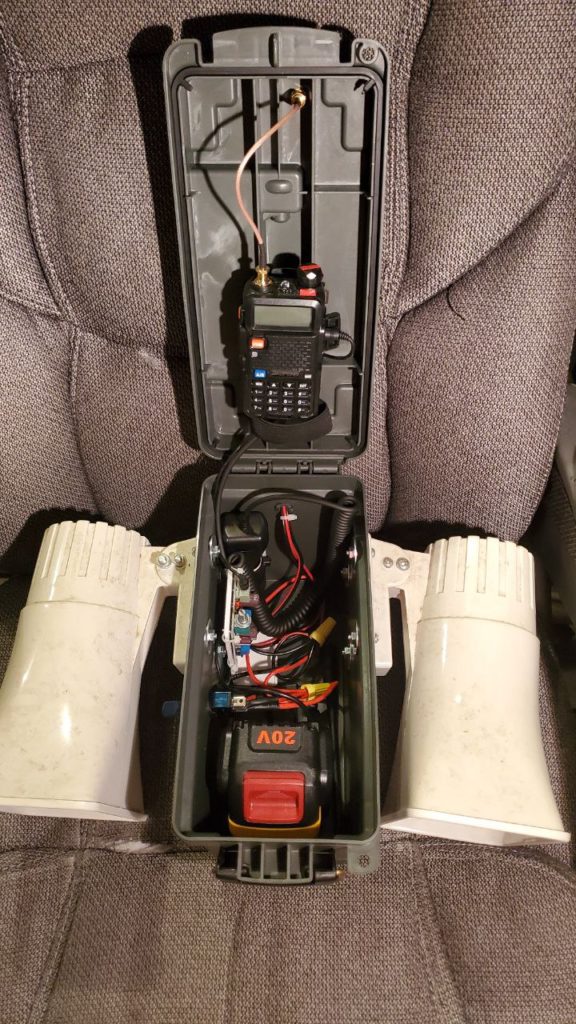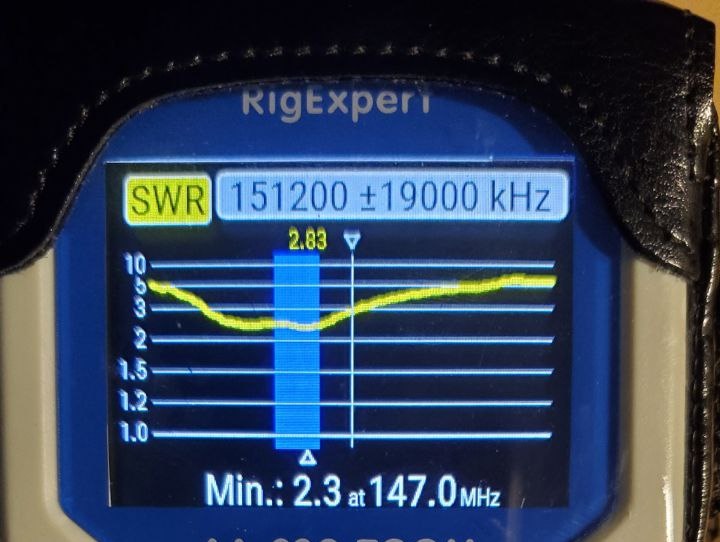G̷̦̒̍o̶̯̻͚̍̒ͅǫ̶̋d̵̫͚̭̋͜͠ ̶̮͔̭̠̀m̷̨̩̗̌o̷̢͎̱̣͑r̴̰̞̲̘͂̚n̵͈͍̼̋͒͝ï̴̥̗̉n̶̯̄̓g̵̛̲͇̬̽̐͐ ̵̰̦̦̒̕͝c̴̬͎̳͍̔ȧ̸̯̩̺̀̈́m̷͍͉̿͋ͅp̵̮̳͎̉͒̋͘e̸͓̤͗r̶̗͒̐̕͠s̷͈̺̯̐̓
Let me tell you the tale of the Squawk Box.
Several years ago I made a wireless PA system for the camping event I help run. It’s been a boon. Makes it easy to ring the dinner bell, and keep people in the loop on when events are starting. But for some reason this year the loudspeakers started blasting static and annoying my campers.
I was pulling my hair out. Did the cheap radios I used go bad in the off-season? Did a new noise source get installed nearby and drown out my signal? Or is there a fundamental flaw in my system design? Let’s investigate.

Look at this clever, compact design. Everything in a nice water-resistant box. I mounted the antenna externally for better reception.
But wait, walkie-talkie antennas are designed to use the metal body of the radio itself as part of the antenna.

What do these graphs mean though? The device I’m holding is an antenna analyzer that measures the Standing Wave Ratio. SWR is a measure of how much energy is radiated vs how much is reflected back to the transmitter. There are some caveats, but for a simple antenna it is a good approximation of how well the antenna is doing its job.
SWR:
- 1: Perfect
- 2: Marginal
- 3+: Poor performance, and potential damage to a transmitter.
A bit like a guitar string, antennas can be tuned to a resonant frequency. For a given frequency, a perfect antenna would radiate 100% of the power at the desired frequency, while simultaneously blocking out the noise on all other frequencies when receiving. Of course the real world doesn’t like physics homework problems, so what you get is something like the above image. Close to 1:1 at the desired frequency, with the SWR getting higher the further away you get from it.
My design separates the antenna from the radio with a short pigtail jumper. Surely that can’t affect the performance all that much.

Oh…that’s not great.
This shows us two things
- The best case SWR is pretty marginal.
- The relative flatness of the curve allows in more noise from undesired frequencies.
Why does adding a short piece of coax make our antenna so much worse? Two words: Ground Plane
The most basic antenna is a dipole, two equal lengths of wire cut to the appropriate length, and strung in opposite directions. The RF current can go out one leg, and return through the other. Perfectly balanced, but dipoles take up a lot of space, so there’s a physics hack antenna designers use so they only have to supply one half of the dipole. The Ground Plane.
Due to some fancy math, you can use the earth itself as an imaginary half of the antenna. There’s a longer explanation of how this works here.
The neat thing is, you don’t even need the earth to be the earth, you can implement an artificial “ground plane” with any conductor.
But back to our setup. Every handheld radio I’ve encountered has a metal plate inside. It’s an imperfect ground plane, but “good enough” that the trade-off for compactness is worth the minimal performance hit at lower power.
The plastic box I mounted the external antenna to is decidedly not metal, and does nothing to provide a ground plane for the half-incomplete antenna. So how do we fix this?
One way would be to mount a piece of sheet metal at the base of the antenna. Easy enough, but now I have a nice finger-slicer when I’m setting the thing up. There’s an easier way though.
Why don’t we just make our half-dipole a full-dipole? Let’s add a short length of wire to the return path and see what happens. I eyeballed the length to be a bit longer than I thought I’d need, then using the antenna analyzer cut off an inch at a time until the SWR was lowest at my desired frequency.

Wow! Everything is right with the world. Not bad for $0.20 of material.